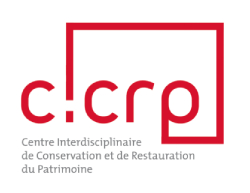Après des collaborations répétées avec le MAP-Gamsau à partir de 2009, le LABoratoire COMmun (LabCom) MAP-CICRP a vu le jour en 2015 par un accord cadre du ministère de la Culture et du CNRS, comprenant le CICRP et l’UMR 3495 MAP (Modèles et simulations pour l’Architecture et le Patrimoine :
http://www.map.cnrs.fr/).
Ce LabCom a institué une gouvernance bicéphale des directeurs des deux institutions, un comité technique et des modalités de coopération dont les programmes SUMUM, Phorayver-2 ou POMMIER, entre autres, sont de parfaites illustrations.
Sa thématique porte sur la conservation-restauration du patrimoine en prenant en compte l’enrichissement des méthodologies d’études par l’expérimentation sur des objets et œuvres patrimoniaux, ainsi que par l’interprétation des questionnements formulés par les scientifiques et les professionnels de la conservation du patrimoine.
Ses recherches visent :
- la connaissance matérielle des biens culturels par l’usage de moyens d’investigation non destructifs et la fusion de données multisources – documentation, imagerie scientifique, analyse des matériaux – et leurs représentations ;
- l’interaction entre les biens culturels, leur matérialité et l’environnement où ils sont placés, les paramètres environnementaux pouvant être structurels – climat, localisation – ou conjoncturels – pollution, éclairage, exposition, gestion, public. Les processus de démocratisation et d’accroissement du tourisme culturel constituent un enjeu majeur pour la conservation des biens culturels et entraînent des exigences accrues en conservation préventive et en conservation-restauration ;
- le développement d’outils de modélisation des mécanismes de dégradations afin d’appréhender l’évolution matérielle du bien culturel dans le temps, confronté à son environnement ou suite à des interventions sur le bien. Les compétences de l’équipe scientifique du CICRP et l’utilisation partagée de l’instrumentation scientifique d’analyse, de vieillissement et de modélisation du CICRP et du MAP constituent un appui technique conséquent au service de la conservation des biens culturels.
En 2022 a été établi et communiqué à l’HCERES, le bilan d’activité du quinquennat (période 2017-2022) de l’UMR-MAP et du LabCom MAP-CICRP.
En 2023, dernière année d’existence du MAP en temps qu’UMR, les ateliers de réflexion et de consultation pour le renouvellement de la relation entre le MAP et le CICRP, initiés en 2022, se sont poursuivis, afin d’envisager les collaborations futures à mettre en place en 2024, entre le Gamsau, future UPR et entité marseillaise de l’ex-UMR-MAP, et le CICRP.
